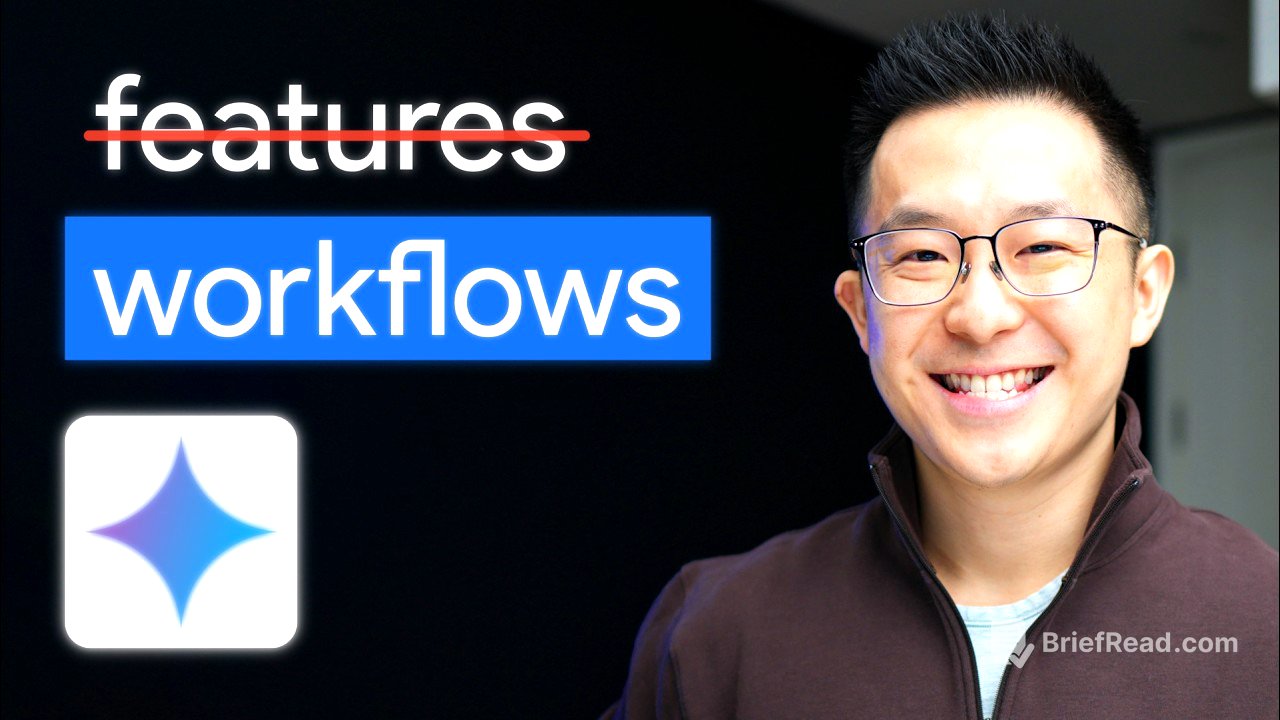TLDR;
This video provides a tutorial on how to effectively use Google Gemini, focusing on practical tips and use cases that remain relevant despite the rapidly changing AI landscape. It covers essential setup configurations, preferred workflows, model selection, and productivity enhancements within the Google Workspace ecosystem. The video also highlights Gemini's strengths, such as its deep integration with Google apps and large context window, as well as its limitations, particularly its sensitivity to certain topics.
- Optimizing Gemini setup within Gmail and the Gemini web app for enhanced functionality.
- Leveraging Gemini for extracting insights from YouTube videos and applying them to personal projects.
- Understanding the differences between chat and reasoning models to optimize response speed and accuracy.
- Utilizing Gemini's integration with Google Workspace for productivity gains in Gmail, Sheets, Docs, and Drive.
- Acknowledging Gemini's sensitivity as a potential drawback.
Setup Tips for Google Gemini [0:12]
To maximize Google Gemini's capabilities, users should first adjust settings within Gmail. Specifically, enabling "Smart features" and "Google Workspace smart features" under the general settings enhances Gemini's integration with other Google services. Additionally, in the Gemini web app settings, users can select which app extensions to enable, such as Google Workspace and YouTube, to streamline their workflow and avoid unintended triggers of less frequently used apps.
My Favorite Gemini Workflow [0:51]
The presenter shares a preferred workflow using Google Gemini that involves extracting insights from YouTube videos and applying them to personal projects. This process begins with sharing a relevant YouTube video with Gemini, then prompting Gemini to extract key takeaways and frameworks from the video. Finally, the user asks Gemini to apply these learnings to their own work. For example, the presenter demonstrates how to use Gemini to extract storytelling frameworks from a Philip Hum video and then apply those frameworks to improve a presentation draft. While Gemini can technically perform tasks within other Google Workspace apps, the presenter finds it more efficient to handle those tasks directly, with the exception of using the mobile version for voice-activated task creation.
Choosing the Correct Gemini Model [2:46]
Selecting the appropriate Gemini model is crucial for optimizing performance. The video differentiates between chat models (Flash) and reasoning models (Pro), advising users to default to the Pro model for complex tasks and switch to Flash for simple requests requiring quick answers. Chat models are suitable for tasks needing several back-and-forth interactions, while reasoning models plan steps and self-correct to provide a final response. An example is provided of translating simplified Chinese characters (Flash model) versus translating formal business Chinese with nuanced implications (Pro model).
Transform PDFs into Games [5:21]
Google Gemini can transform dense documents, such as AI agent white papers, into interactive games. By uploading a PDF to Gemini, selecting the Pro model, and enabling the canvas feature, users can prompt Gemini to create a game that tests their knowledge of the material. The AI will generate functional games with elements like progress bars, offering a more complete result compared to similar features in other platforms like ChatGPT and Claude, often requiring fewer follow-up prompts.
Productivity Tips for Google Gemini [6:22]
Gemini's deep integration within the Google Workspace ecosystem, particularly through the Gemini side panel, enhances productivity by minimizing context switching. The side panel, accessible after enabling smart features in Gmail, allows users to input unstructured thoughts and receive coherent, professional responses for emails or create tables in Google Sheets to track registrations based on invitation channels. Additionally, within Google Sheets, the AI function can categorize feedback or translate text without needing traditional formulas. In Google Docs, the side panel can generate summaries or insert AI summary blocks for lengthy documents, and in Google Drive, it can summarize files within a project folder and draft reports.
Gemini’s Massive Context Window [9:54]
Gemini's large context window allows it to process massive amounts of data, making it suitable for tasks like analyzing lengthy industry reports. Unlike Claude, which may struggle with large documents, Gemini can handle multiple large documents without reaching its context window limit. This capability is particularly useful for tasks requiring the AI to ingest and analyze extensive data sets.
Google Gemini’s Biggest Weakness [10:35]
A significant downside of Google Gemini is its sensitivity, which can lead it to refuse legitimate requests. The presenter shares an experience where Gemini initially declined to explain why former President Jimmy Carter was remembered more for his failures, citing the topic as too sensitive. In contrast, other AI apps like ChatGPT and Perplexity provided objective answers to the same question. While AI safety principles are important, excessive sensitivity may cause users to prefer alternative AI applications.
